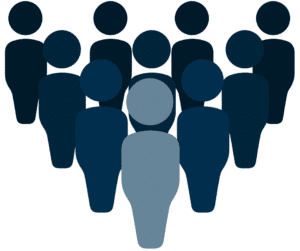 The chain of command in a company refers to the different levels of command within the organization. It starts with the top position such as CEO or the business owner, all the way down to the front-line workers. Companies create a chain of command in order to flow instructions downward and accountability upward by providing each level of workers with a supervisor.
The chain of command in a company refers to the different levels of command within the organization. It starts with the top position such as CEO or the business owner, all the way down to the front-line workers. Companies create a chain of command in order to flow instructions downward and accountability upward by providing each level of workers with a supervisor.
Establishing a Chain of Command
Each company has a different organizational structure, which translates to its chain of command. A company’s hierarchy starts with the CEO at the top. Following the CEO are the vice president and upper management employees who report directly to the CEO. Then, there are department managers and supervisors who report to the higher-level executives. Lastly, come the front-line workers who report to their respective supervisor and department manager. Every employee recognizes the structure of the company when a chain of command is in place.
Click here to Download the How to be a Wingman Guide
Levels of Management
There are three general levels of management: top, middle, and front-line managers.

Top Managers
Top managers are in charge of the overall performance and health of the company by controlling and overseeing the entire organization. They are the ones who set the goals, objectives, and mission for the company. Top-level executives spend the majority of their time planning and decision-making and consistently scan the business environment for opportunities and threats.
Some of their duties include:
- Set company goals and objectives
- Scan external environment
- Plan strategically and make decisions
Some examples of a top managers include the following: Board of directors, chief executive officer (CEO), chief financial officer (CFO), chief operating officer (COO), president, and vice president.
Middle Managers
Middle managers are responsible for achieving the objectives set by the top managers by developing and implementing activities. They oversee the first line managers and make sure they are properly executing the activities they set out.
Some of their duties include:
- Report to top management
- Oversee first-Line managers
- Allocate resources
- Design, develop and implement activities
Some examples of a middle managers include the following: General managers, department managers, operations manager, division manager, branch manager, and division manager.
First-Line Managers
First line managers are in charge of supervising employees and coordinating their day-to-day activities. They need to make sure that the work done by their employees is consistent with the plans that the upper management set out for the company.
Some of their duties include:
- Report to middle managers
- Supervise employees
- Organize activities
- Involved in day-to-day business operations
Some examples of a first-line manager include the following: department head, foreman, office manager, section head, shift boss, and supervisor.
Advantages of a Good Chain of Command
There are numerous advantages that can come from having a good Chain of Command, including the following:
Responsibility – Having different areas of the business can improve accountability by giving everyone a different responsibility. Everyone has their own separate duties, and their own supervisor to keep them accountable.
Efficiency – A functional chain of command helps improve efficiency when communicating with workers. As a result, this helps them improve workflow and adjusting their management methods.
Clarity – Having a good company structure makes the chain of command very clear. Furthermore, this lets everyone know which decisions they are allowed to make and which ones to present to their supervisors.
Employee Morale – Companies that have a clear chain of command create an environment without uncertainty and chaos. It improves the morale of workers leading to high productivity and low employee turnover.
Career Path – It makes it easier to create career paths for employees and track their progress toward their goals outlined in their respective areas.
Specialization – Making employees focus on narrow functional areas can create groups of specialists that heavily impact the functions of the company.
Why Chain of Command Matters to a CFO
Even though most top-level executives do not often interact with front-line operations, they still need to be aware of everything that is going on in the company. CFOs especially need to make sure their ideas/objectives are properly being executed and delegated through the chain of command. Even if top-management has the biggest impact on the company, front-line workers are the ones that interact the most with the customer most of the time. For example, ABC Co. is a company that owns office supply stores. The store employees are constantly receiving criticism for being rude and uncourteous to customers – ultimately leading to people choosing to buy office supplies elsewhere. This can directly affect the company’s revenues and therefore, the CFO‘s projections. A good top-manager should occasionally check on its bottom managers to see if they are properly carrying out their tasks to prevent problems like this from happening.
Tip: Walk in the store-front or factory floor at least every week or every other week. Get to know the people that are dealing with your customers or are producing your product. They will also let you in on the secrets that mid to upper management either won’t tell you or simply don’t know.
If you want to take your career as the CFO to the next level, then you need to start acting like your CEO’s wingman. Be the eyes and ears for the company. Click here to access the How to Be a Wingman guide.






















